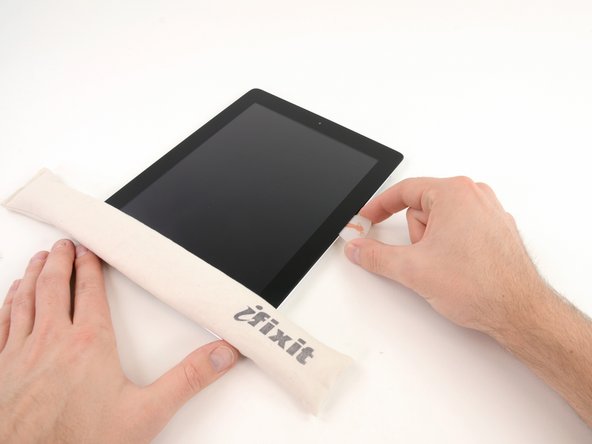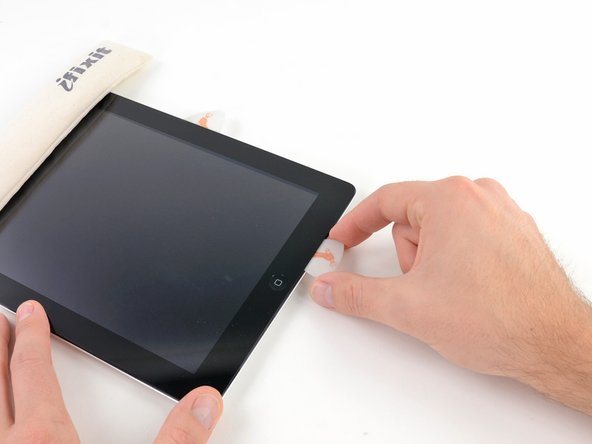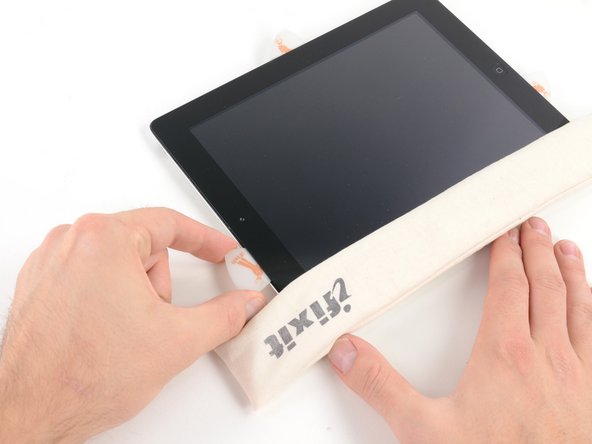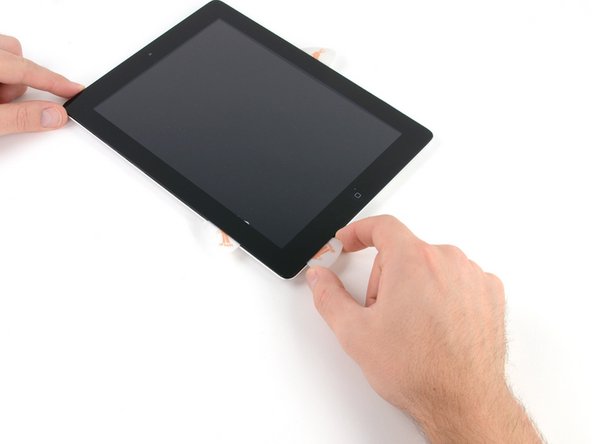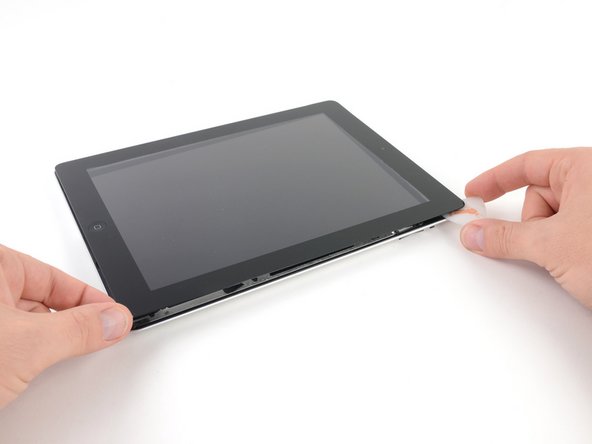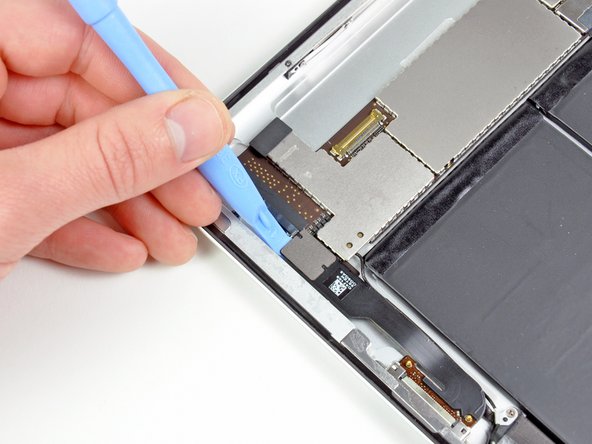iPad 2 GSM Speaker Assembly Replacement
Duration: 45 minutes
Steps: 65 Steps
Follow this guide to swap out a busted speaker assembly like a pro. The pics are mostly from a Wi-Fi model, so the inside might look a bit different if you have a cellular version. Don’t worry though—the steps are basically the same, except where we point out the differences.
Step 1
For carousel microwaves: Ensure that the plate can spin without a hitch. If your iOpener gets caught, it could overheat and cause a bit of trouble.
We suggest giving your microwave a good cleaning before diving in, as any leftover mess on the bottom could end up making friends with the iOpener.
- Pop that iOpener right in the middle of the microwave like it’s the star of the show!
Tools Used
Step 2
Hey there! Just a friendly reminder to keep an eye on that iOpener while you're working your magic. We don't want it to get too toasty—overheating could lead to a bit of a pop! So, let's keep the heat under 100˚C (212˚F).
If your iOpener looks a little puffy, give it some space and don’t touch it.
If the center of the iOpener is still feeling hot, just hang tight and let it cool down a bit more before you reheat it. A nicely warmed iOpener should stay cozy for about 10 minutes!
Microwave power levels vary, so you might need to heat the iOpener for a bit more or less time. You'll know it's ready when it feels just a tad too warm to handle—perfectly toasty!
- Give your iOpener a cozy thirty-second spa session in the microwave.
- As you work your magic on the repair, remember to pamper your iOpener by reheating it in the microwave for another thirty seconds whenever it starts to feel chilly.
Tools Used
Step 3
Caution! The iOpener is going to be super hot, so handle it with care. An oven mitt could be your best buddy here!
- Carefully take the iOpener out of the microwave by grabbing one of the flat ends—steer clear of the hot middle to keep your fingers happy.
Tools Used
Step 4
Be careful! The iOpener is going to be sizzling hot, so just grab it by the end tabs to keep your fingers safe and sound.
If a microwave isn’t in your toolkit, don’t worry! Just follow this step to warm up your iOpener using boiling water.
- Grab a pot or pan and fill it with enough water to completely cover your iOpener. We're talking a cozy bath for your tool!
- Heat that water until it’s bubbling like a hot spring. Once it’s boiling, turn off the heat and let’s get to the fun part.
- Carefully place the iOpener into the steamy water for about 2-3 minutes. Make sure it's fully submerged – we want it to be nice and warm all over.
- Using some trusty tongs, fish out the heated iOpener from its cozy bath. Watch out – it’s hot stuff!
- Give that iOpener a good dry-off with a towel. We want it all nice and dry for action!
- Boom! Your iOpener is now all set and ready for action! If you ever need to reheat it, just repeat the boiling water steps. If things get tricky, don’t hesitate to schedule a repair!
Tools Used
Step 5
- Grab a SIM eject tool or a straightened paperclip and gently pop out the SIM card tray.
Step 6
- Gently slide the SIM tray out from its slot and take it out of your iPad 2.
- If you’re swapping SIM cards, pop the old one out of the tray and pop your new card in.
Step 7
Don your safety glasses to keep those peepers safe, and watch out for that delicate LCD screen!
This will help keep those pesky glass shards in check and add some solid support when you're prying and lifting the display.
- If your display glass is cracked, let's keep it from shattering even more and protect yourself during the repair by adding some tape to it.
- Place overlapping strips of clear packing tape across your iPad's display until the entire surface is covered up.
- Try your best to follow the rest of the guide as laid out. Just a heads up, once the glass is cracked, it might keep on cracking while you work, and you might find yourself needing a metal prying tool to scoop out those pesky glass pieces.
Step 8
Just a heads up! Since you might be dealing with some sharp glass bits during this process, we totally recommend rocking a pair of safety glasses to keep those flying shards at bay. Stay safe and stylish!
- Place the iOpener flat along the right edge of the iPad, pressing it down so it makes solid contact with the iPad's surface.
- Let the iOpener hang out there for about 90 seconds to warm things up before you try to open the front panel.
Tools Used
Step 9
Getting the wedged tip of the opening tool between the glass and plastic might take a little muscle. Stay cool, be patient, and gently wiggle that plastic tool back and forth until it slides in nicely.
- Take a look at the upper right corner of your iPad, where you'll find a tiny gap in the adhesive ring—it's about 2.0 inches (or ~5 cm) from the top. This little weakness is your golden ticket!
- Now, let’s get our tool ready. Line it up with the mute button and gently insert the tip of a plastic opening tool into that gap between the front glass and the plastic bezel. Just slide in the very tip of the tool—enough to open up that crack a bit wider.
Step 10
- Carefully slide the tool right where the plastic display bezel meets the front panel glass—think of it as finding the perfect spot to gently pry things apart.
Step 11
- Gently wedge the tip of your plastic opening tool between the front glass and plastic bezel, then slide a plastic opening pick right into the gap next to it to keep things moving smoothly.
Step 12
- Take that trusty plastic opening tool out of the iPad's grip, and slide the opening pick a little deeper under the front glass—about half an inch should do the trick!
Step 13
- As you gently work on loosening the adhesive on the right side of your iPad, don’t forget to reheat that trusty iOpener and pop it back on the bottom edge of the iPad. You're doing great!
Tools Used
Step 14
The adhesive is pretty strong, so you might need to apply a bit more muscle. Just take it slow and steady.
If you can spot the tip of the opening pick peeking out from under the front glass, give it a gentle tug to pull it out just a smidge. Don't worry, using the pick this deep won't harm anything, but it might leave some adhesive residue on your LCD, and nobody wants that!
- As you warm up the bottom edge with the iOpener, it's time to tackle that pesky adhesive along the right edge of your iPad. Let's get to it!
- Gently slide the opening pick down the side of the iPad, and watch that adhesive give way like magic!
Tools Used
Step 15
You might need to slide the heated iOpener back over to the right edge of the iPad while loosening the adhesive. How long the iPad has had to cool down during your work will decide if this move is needed.
- If the opening pick gets stuck in the adhesive, just gently 'roll' it along the edge of the iPad to keep breaking that sticky seal.
Tools Used
Step 16
- Before you pull the first pick from the bottom corner of the iPad, slide a second pick under the right edge of the front glass. This keeps the adhesive from sticking back down while you're working.
- Give your iOpener another quick reheat, then move it to the top edge of the iPad for a smooth separation.
Tools Used
Step 17
The Wi-Fi antenna is secured with screws and a cable along the bottom right edge of the iPad's rear case. Since it’s positioned just so, take your time and handle it gently to avoid any permanent damage to this sneaky little component.
- Alright, folks! We're about to plunge into some serious repair action, so let’s keep our wits about us. Safety first, right?
- Next up, we’re going to gently release the sticky stuff holding the antenna to the front panel. Just remember, we want to do this without causing any mishaps with the tiny components that connect the antenna to the bottom of the iPad. Take your time and follow along with the upcoming steps—you're going to do great!
Step 18
Keep the pick from sliding past the bottom right corner—going further might mess up the Wi-Fi antenna, and we definitely don’t want that!
- Gently slide the opening pick around the bottom right corner of your iPad to free up that pesky adhesive. You've got this!
Step 19
Take your time when sliding the opening pick along the bottom right edge of the front panel! The Wi-Fi antenna is lurking nearby, and it can be a sneaky little thing—too much adhesive release, and you've got a problem on your hands.
Keep that pick cozy under the front glass—just pull it out a smidge so about 1/8" (3 mm) of the tip is still snuggled in there. You've got this!
- Gently run the edge of your opening pick along the bottom side of the iPad to free up the adhesive near the Wi-Fi antenna. You've got this!
Step 20
- Alright, you're almost there! Once you've passed the Wi-Fi antenna (that's about 3 inches or 75 mm from the right edge, right by the home button), pop that opening pick back in all the way. You've got this!
- Now, gently slide that pick to the right to break free the adhesive that’s been holding the Wi-Fi antenna snug against the front glass. Easy peasy!
- The antenna is held on to the bottom of the iPad with some screws and a cable. This step is super important because it disconnects the antenna from the front panel, making sure it stays safe and sound when you lift the panel off.
Step 21
Keep your iOpener's heating sessions short and sweet—no more than a minute at a time! Give it a breather for at least two minutes before you heat it up again. Your iOpener will thank you for it!
If the adhesive has cooled down too much along the bottom edge, give that iOpener a little love and reheat it to warm up the adhesive where you're working.
- Keep on peeling away the adhesive at the bottom of the iPad. Make sure to pull the opening pick out far enough to loop around the home button. Once you've bypassed the home button, slide it back in to about half an inch (10 mm) deep. You've got this!
Tools Used
Step 22
When working on iPad 4 models, slide your pick in no deeper than 1/2 inch (10 mm) here to keep that home button ribbon cable safe and sound.
- Keep peeling away that adhesive along the bottom edge of the iPad like a pro!
- Once you've got a good spot, slide that opening pick under the front glass near the home button and let it hang out there.
Step 23
- Heat up the iOpener in the microwave, then place it on the left edge of your iPad to gently warm up the stubborn adhesive hiding there.
Tools Used
Step 24
If the adhesive has cooled down too much, just swap in a fresh iOpener along the top edge and keep on trucking! If that iOpener isn't feeling warm anymore, give it a little reheating love.
- Gently slide that opening pick along the top edge of your iPad, giving it a little pull to navigate around the front-facing camera bracket.
- The adhesive in this area is quite robust, so don’t be shy about using some muscle! Just take your time and be careful—no one wants to harm their iPad or themselves.
- If your opening pick feels like it's stuck in the adhesive, try giving it a little 'roll' as demonstrated in step 9.
Tools Used
Step 25
If the adhesive is feeling cozy and warm, go ahead and take that iOpener off the iPad for some ease. But if it's still clingy like a puppy, just give the iOpener another quick heat-up and place it on the left edge while you tackle the task at hand.
- Keep peeling the adhesive along the iPad’s top edge, and carefully slide your opening pick around the top left corner like a pro.
Tools Used
Step 26
Hey there! The digitizer cable is hanging out about 2" (50 mm) from the bottom of your iPad. So, as you're sliding that pick, make sure to stop when you reach around 2.25" (60 mm) from the bottom. Keep it cool and steady!
- Gently glide the opening pick along the left edge of your iPad, freeing up that sticky adhesive as you go. It's a bit thinner over here because of the digitizer running along the entire left side. Just be sure not to go too deep—keep it to about half an inch (10 mm) max to avoid any accidental damage to the digitizer. You've got this!
Step 27
Heads up! The bottom of the digitizer cable is just about an inch (25 mm) from the bottom edge of the iPad. Take it slow and steady to avoid accidentally cutting this little guy!
- Slide the opening pick gently under the bottom edge of the iPad and work your way releasing the adhesive at the bottom left corner. Keep it cool and steady!
Step 28
Some of the sticky stuff around the edge of your iPad might have decided to stick back down. If that’s the case, gently slide a pick under the spot where the front glass is still holding tight and carefully slice through the adhesive.
- With one of those handy opening picks, give the bottom right corner of the iPad a gentle nudge to lift it up, then use your fingers to grab hold. Let's get to it!
Step 29
Watch out for any stubborn adhesive still hanging on! Grab an opening pick and gently slice through any glue keeping the front panel stuck.
- Grab the iPad by the top and bottom right corners, then gently swivel the front glass away from the device.
- When putting everything back together, give the LCD a quick once-over with a microfiber cloth and some compressed air to zap away any dust or fingerprints before snapping the glass back on.
Step 30
- Unscrew the four 2.0 mm Phillips screws holding the LCD to the back case—time to loosen things up and get this display free!
Step 31
- Gently lift the LCD from the edge closest to the volume buttons and swing it out of the rear case like a pro.
- Carefully set the LCD down on the front panel, just like you see in the second picture.
Step 32
Remember to pry gently on the hinged retaining flaps—not the sockets themselves—to keep everything safe and sound.
Check out the red highlights in the second picture—they’re pointing out the retaining flaps you need to watch out for.
- Gently use the edge of a plastic opening tool to lift up the retaining flaps on the two digitizer ribbon cable ZIF sockets. You've got this!
Step 33
- Grab your trusty plastic opening tool and gently coax that digitizer cable off the shields on the logic board. It's like peeling a banana, but way more techy!
- Now, with a gentle touch, carefully lift the digitizer cable away from the adhesive that's keeping it snug against the side of the rear case. You're doing great!
Step 34
- Gently pull the digitizer ribbon cable straight out from its two sockets on the logic board. Keep it smooth and steady!
Step 35
Handle the LCD with care, and remember, it's not going anywhere! Just gently rotate it over while keeping the cable connected. You've got this!
To get that front panel assembly off, you'll need to gently slide the ribbon cable out from between the case and the LCD. A little maneuvering of the LCD will create the space you need to make this happen.
- Carefully lift the LCD from its long edge farthest from the digitizer cable and gently flip it back toward the rear case, just like closing a book.
- While holding the LCD up, slowly slide the front panel away from the iPad. Watch out so the digitizer cable doesn’t get caught on the rear case or LCD.
- Place the LCD back into the body safely for now.
Step 36
To dive into the iPad's inner workings, we first need to gently lift the LCD out of its cozy case.
- Gently lift the LCD from the edge nearest to the volume buttons and flip it out of the rear case, just like you're turning the page of your favorite book—super smooth!
- Now, place the LCD face down on a clean, soft surface to keep it scratch-free. A cozy cloth will do wonders!
Step 37
Be sure to disconnect the connector gently; pulling it straight up could cause some trouble.
- Gently place the LCD right next to the rear panel.
- Grab a plastic opening tool and nudge the display data cable lock upwards.
- Carefully pull the display data cable out from its socket.
Step 38
- Gently lift the LCD assembly away from the rear panel assembly to separate them.
Step 39
- If you spot a piece of tape covering the end of the dock connector cable, grab a plastic opening tool to gently lift it off.
- Carefully use the edge of your plastic opening tool to pry the dock connector cable's plug up from its socket on the logic board—take it slow and steady.
- Peel the dock connector ribbon cable away from the rear panel like you're revealing a secret.
Step 40
- Gently lift the speaker cable connector straight up from its cozy home on the logic board.
Step 41
Make sure you're gently pushing up on the hinged retaining flap, not the socket itself. You've got this!
- Gently use the edge of a plastic opening tool to lift the little flap holding down the headphone jack and front camera cable ZIF socket.
- Carefully peel the headphone jack and front camera cable away from the back case.
Step 42
- Gently wiggle and pull the headphone jack and front camera ribbon cable straight out from their socket on the logic board.
Step 43
Keep it chill and don’t yank the cable upward when disconnecting it.
- Take your trusty plastic opening tool and gently pry up the retainer holding that upper component board cable connector snug in its socket on the logic board.
- Now, give the connector a little nudge and carefully pull it out of its socket on the logic board.
Step 44
- Unscrew the three tiny 2 mm Phillips screws holding the SIM card slot onto the back panel—time to get those little guys loose!
Step 45
- Unscrew the two 2.9 mm Phillips screws that are keeping the headphone jack snugly in place on the top edge of the rear panel. You've got this!
Step 46
- Grab a plastic opening tool and gently pry the headphone jack out from its snug spot at the top of the rear panel.
- Carefully peel the headphone jack and SIM slot assembly away from the top edge of the communications board like you're easing off a sticker.
Step 47
- First up, let's tackle those pesky little 2.1 mm Phillips screws that are keeping the logic board bracket snug as a bug to the rear case, right by the digitizer cable socket. Unscrew them with care!
- Now, gently lift the logic board bracket away from the rear case. You're doing great!
Step 48
- Unscrew the four 2.6 mm Phillips screws that are holding the logic and communications boards to the rear panel. You've got this!
Step 49
- Carefully slide the edge of a plastic opening tool under the logic board and gently lift it away from the sticky adhesive holding it to the back case. Take it slow and steady!
Step 50
Hold your horses! Don't go trying to yank it out just yet. We've still got three antenna cables hanging on tight.
- Gently lift the logic board out of the rear case and give it a little twist towards the battery. You're doing great!
Step 51
- Grab your trusty plastic opening tool and gently pop off both antenna connectors from their snug spots on the communications board. Nice and easy!
Step 52
- Gently unplug the Wi-Fi antenna connector from its cozy socket on the logic board. You've got this!
Step 53
- Gently take out the logic board from the iPad 2.
Step 54
Heads up: Don’t let the iOpener get too toasty! Give it at least two minutes to chill before heating it up again, and never pop it in the microwave for over one minute.
If your iOpener has cooled down a bit too much during your breaks, just pop it back in the microwave for another minute to warm it up again!
- Microwave the iOpener for one minute to get it nice and toasty!
- Now, place that warm iOpener right on the back of your iPad, just to the right of center (you know, the side that's away from the rear-facing camera). Let it chill there for 90 seconds to help loosen that pesky battery adhesive.
- Next up, shift the iOpener to the center of the back of your iPad and give it another 90 seconds to work its magic.
- Finally, move the iOpener to the left edge (where the rear-facing camera is) and let it hang out for another 90 seconds. You're almost there!
Tools Used
Step 55
If that adhesive is being stubborn, give the rear panel another warm-up and try peeling it off again.
- Let's kick things off with the battery cell that's cozy next to the dock connector. Grab your trusty plastic opening tool and slide it under the edge of that battery, right by the logic board void. We're just making a little wiggle room to slide in the flat end of our spudger!
- Now, take that spudger and glide it along the two long sides of each battery cell. We're aiming to totally free them from the sticky adhesive that's keeping them snug against the rear case. You're doing great!
Tools Used
Step 56
Take it easy bending the battery connector board—no need to do the limbo! Watch out especially when prying near that little post sticking up from the aluminum rear case to keep everything safe and sound.
- Before you gently pop up that middle battery cell, take a plastic opening tool and use its edge to carefully lift the battery connector board off the rear panel. It's like giving your phone a little breather before diving in.
Step 57
- Now grab your spudger and gently work along the long sides of the middle battery cell to separate the adhesive.
- Repeat this for the last battery cell, and if needed, give the case a little heat to loosen things up.
Tools Used
Step 58
- Gently lift the battery from the back panel and take it out of the iPad 2.
Step 59
- Gently lift up the dock connector and speaker cables to uncover the Wi-Fi antenna cable lurking beneath.
- Carefully detach the Wi-Fi antenna cable from the rear panel.
Step 60
- Let's kick things off by unfastening the screws holding everything together:
- First up, grab those two 2.0 mm Phillips screws.
- Next, don't forget about those two 1.7 mm Phillips screws.
Step 61
- Gently peel off the Wi-Fi antenna from the speaker enclosure and take it out of the iPad 2. You've got this!
Step 62
Make sure those little rings of EMI foam are still happily attached to the dock connector cable!
- Carefully separate the dock connector cable from the speaker cable.
Step 63
- Grab a plastic opening tool and gently slide it under the edge of the tape that's holding the speaker assembly to the back panel. Be careful not to tear it!
- Now, use your fingers to peel off the tape from the speaker assembly. It should come off without too much fuss.
Step 64
- Unscrew these two little guys:
- A 3 mm Phillips screw
- A 2.1 mm Phillips screw
Step 65
- Gently wedge the edge of a plastic opening tool under the right side of the rear panel to nudge the speaker assembly out.
- Lift the speaker assembly away from the iPad 2 and set it aside.




























